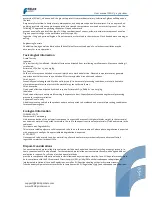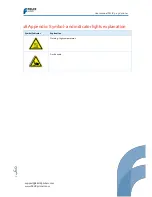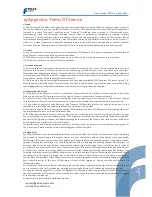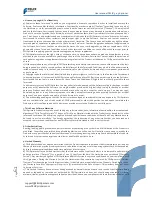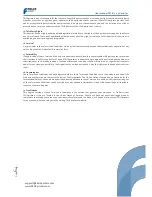
P
age
56
support@FELIXprinters.com
www.FELIXprinters.com
User manual FELIX 3.0 3d printer
17
Appendix: Material Data Safety Sheet
17.1
PLA
Hazards Identification
Appearance:
Clear, translucent, opaque, pellets.
Physical state:
Solid
Odor:
Sweet
Potential health effects:
Eye contact: Contact with eyes may cause irritation.
Skin contact: Substance may cause slight skin irritation.
Ingestion: Ingestion may cause gastrointestinal irritation, nausea, vomiting and
diarrhoea.
Inhalation: Inhalation of dust may cause shortness of breath, tightness of the chest,
a sore throat and cough. Low hazard for usual industrial or commercial handling.
Target organ effects: There were no target organ effects noted following ingestion or
dermal exposure in animal studies.
Sensitization: Did not cause sensitisation on laboratory animals
Flammability: Fine dust dispersed in air may ignite.
First-aid measures
Eye contact: Rinse immediately with plenty of water, also under the eyelids, for at least 15 minutes. Call a physician
immediately.
Skin contact: Rinse immediately with plenty of water for at least 15 minutes. If skin irritation persists, call a physician.
Cool skin rapidly with cold water after contact with hot polymer.
Inhalation: Move to fresh air. Call a physician immediately.
Ingestion: Drink water as a precaution. Never give anything by mouth to an unconscious person. Do not induce
vomiting without medical advice. Call a physician immediately.
Notes to physician: Treat symptomatically.
Fire Fighting Measures
Flammability:
Autoignition temperature: 388°C
Flammability Limits in Air
Flammable limits in air - lower (%): Not determined
Flammable limits in air - upper (%): Not determined
Suitable extinguishing media: Foam. Water. Carbon dioxide (CO2). Dry chemical. Alcohol resistant foams are preferred
if available. General-purpose synthetic foams (including AFFF) or protein foams may function, but much less effectively.
Extinguishing media which must not be used for safety reasons: No information available Hazardous decomposition
products: Burning produces obnoxious and toxic fumes Aldehydes Carbon monoxide (CO) carbon dioxide (CO2)
Special protective equipment for firefighters: As in any fire, wear self-contained breathing apparatus pressure-demand,
MSHA/NIOSH (approved or equivalent) and full protective gear. Under fire conditions: Cool containers / tanks with
spray water. Water mist may be used to cool closed containers.
Other information: Fine dust dispersed in air may ignite. Risks of ignition followed by flame propagation or secondary
explosions shall be prevented by avoiding accumulation of dust, e.g. on floors and ledges.
Handling and Storage
Safe handling advice: Avoid contact with skin and eyes. Avoid dust formation. Workers should be protected from the
possibility of contact with molten material during fabrication. Low hazard for usual industrial or commercial handling.
Use personal protective equipment.
Storage:
Store in cool place. Keep at temperatures below 122F (50 °C). No special restrictions on storage with other products.
Toxicological Information
Principle Routes of Exposure: Eye contact. Skin contact. Inhalation. Ingestion.
Acute toxicity: There were no target organ effects noted following ingestion or dermal exposure in animal studies.
Local effects: May cause eye/skin irritation. Product dust may be irritating to eyes, skin and respiratory system. Caused
mild to moderate conjuctival irritation in eye irritation studies using rabbits. Caused very mild redness in dermal
irritation studies using rabbits (slightly irritating). Ingestion may cause gastrointestinal irritation, nausea, vomiting and


















